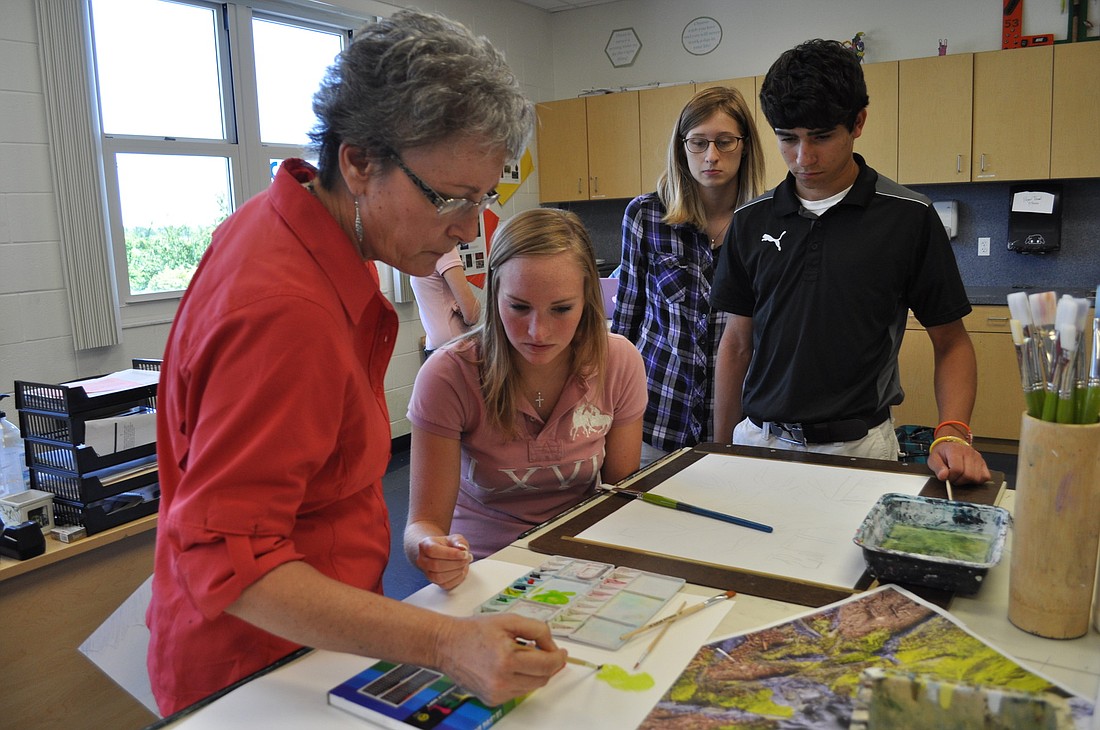- October 19, 2022
-
-
Loading

Loading

LAKEWOOD RANCH — Meg Phillips, a freckled Out-of-Door Academy sophomore with healthy, flowing, orange hair, asked the old man hooked up to an IV what color he envisioned as representing cancer.
The man, a grandfather in his late 70s with bladder cancer, replied, “black.”
“He seemed like a normal guy,” Phillips said of the man, a patient at the Sarasota office of Florida Cancer Specialists and Research Institute. “He’s a grandfather. He’s a person. He seemed pretty chill.”
Phillips, one of seven Out-of-Door Academy advanced art students assigned to interview seven cancer patients and create art for their colorless treatment room, is at ease around people with the disease because of her teacher.
ODA art teacher Paula Kozak has spent her Wednesdays and Fridays the last four months in that same treatment room, staring at empty white walls and plastic IV bags filled with electrolytes and medication.
The only color, an escape, comes from a large fish tank.
Kozak was diagnosed with stage III ovarian cancer in 2010.
That year, Kozak began a mission to make cancer normal for her students, something real they could touch, feel and experience.
Kozak took that conversation beyond the classroom, to the institute.
The students revealed their artwork to the Florida Cancer Specialists and Research Institute patients May 30, more than a month after the April 29 informational interviews meant to guide the direction of the art.
Phillips has been in Kozak’s art classes since lower school at ODA.
“Ms. Kozak is still Ms. Kozak,” Phillips said. “On the days she’s not here, I think, ‘Is she OK?’ But she’s made us become really self-sufficient.”
When Phillips interviewed her patient, even after many interactions with cancer in the classroom, such as henna-dying Kozak’s bald head, she still felt nervous.
She quickly noticed the patient, the man in the yellow shirt, a Korean War veteran, carried a Kindle. She used it as a talking point and asked if he liked to read.
The man said he did, but, then, steered the conversation in a different direction.
He started talking about cats; about how he used to fear them but now has one at home, waiting for his return.
The man didn’t want to look at art that would be abstract and dull.
Back in the classroom, Phillips traced a Google image of two cats looking up at a glob of rainbow-colored grapes.
“I knew this would make the man chuckle, and that’s what he wanted,” Phillips said. “He wanted something not normal, that would take him on a little journey.”
Another, student, sophomore Francisco Marcano, interviewed a woman in her 60s who was suffering from brain cancer.
She lives next to a lake in Summerfield and revels in watching sandhill cranes dip into the water.
Marcano tried to recreate that serenity in his painting, an outdoor picture of trees and lush greens.
It’s a scene Kozak says patients prefer to think about, a journey away from needles and penicillin — the reality.
“These paintings bring back a memory or a moment, a distraction from what’s going into your arm,” Kozak said. “The students cannot be in the treatment room with me, but their art will, and it will make me cry.”
Contact Josh Siegel at [email protected].